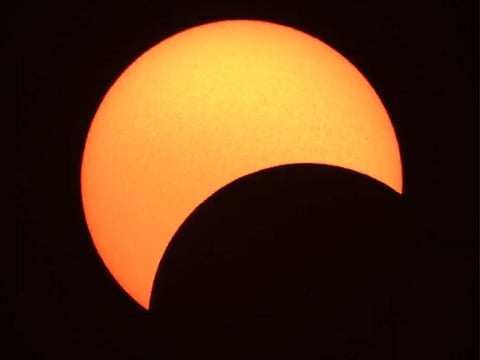Watch: All you need to know about UAE solar eclipse
The UAE’s partial solar eclipse on June 21 coincided with the official start of summer

Also In This Package
Dubai: On June 21, the UAE witnessed a partial annular eclipse, commonly known as a solar eclipse.
The annular eclipses occur when the Moon - passing between Earth and the Sun - is not quite close enough to our planet to completely obscure sunlight, leaving a thin ring of the solar disc visible. And that is why it is also known as the Ring of Fire.
The eclipse, which lasted for around three hours, started between 8am and 11am, and was broadcast live from Abu Dhabi by the UAE Space Agency’s social media channels.
In the UAE, residents saw how the moon was going to cover up to 86.31 per cent of the sun's disk, which reached its peak at around 9.35am.
It began at 8.14 am when the moon started to moving in front of the sun, and will be over by 11.12 am.
Solstice summer eclipse
The solar eclipse also coincides with the official start of the summer, marking the ‘solstice summer eclipse’. The last time such an event of this kind happened was on June 21, 2001, but even then, the solar eclipse was a total eclipse and not an annular one that recreates the Ring of Fire effect.
Hasan Al Hariri, chief executive officer of the Dubai Astronomy Group, advised the public to observe this celestial event by taking all necessary precautions. He said that this is an opportunity for us to understand the dynamics of space and movement of objects surrounding the earth. This level of coverage of the solar disk is not going to happen until the next 25 years.
How to view the eclipse
Al Hariri urged the public to use high quality solar eclipse glasses to observe the celestial event.
During the eclipse, people must refrain from looking directly into the sun without using special sunglasses with special filters.
“The northern regions of the Arabian Peninsula will see 60 per cent coverage of the Sun, and it will also be seen in the rest of the Middle East, Eastern Europe, and other regions in Asia in varying proportions,” said Ibrahim Al Jarwan, member of the Arab Union for Space and Astronomy.
The annular eclipse track will reach only 75 km in width, starting from central Africa at 3.46 am UTC (Coordinated Universal Time) and pass through in Sudan and Ethiopia, across Yemen, some of the Saudi Arabian desert areas, before reaching Muscat in Oman. The eclipse will then continue to Pakistan and northern India at 6.40am UTC, and continue on to China and Southeast Asian countries, before ending in the Pacific Ocean at 9.34 am UTC.
Sign up for the Daily Briefing
Get the latest news and updates straight to your inbox









